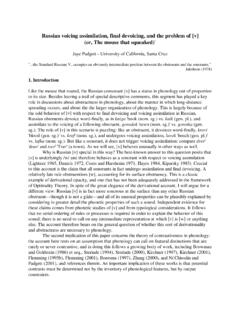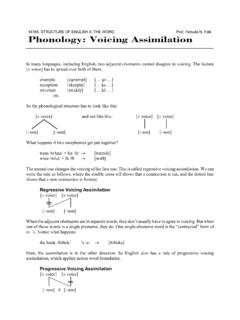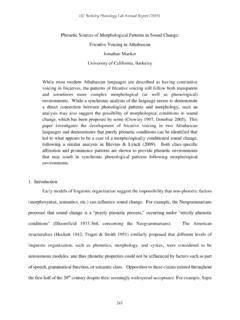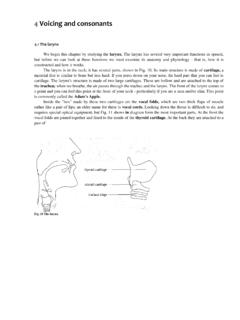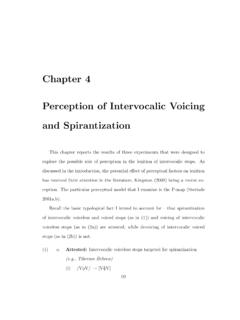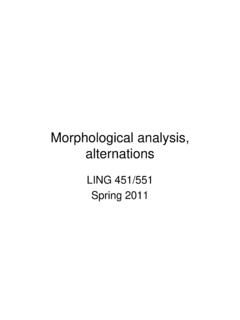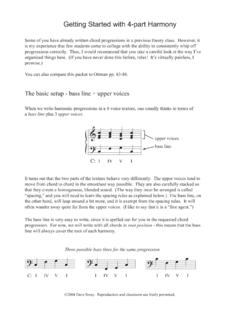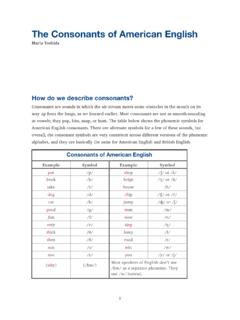Transcription of Voicing Variability and Formal Phonology - Stanford University
1 Incomplete final devoicingDetermining underlying voicingVoicing Variability and Formal PhonologyMarc van OostendorpMeertens Instituut & Leiden UniversityVariation, Gradience and Frequency in Variability and Formal PhonologyVariation, Gradience and Frequency in PhonologyIncomplete final devoicingDetermining underlying voicingVoicing Variability and Formal PhonologyIFinal devoicing seems to pose two major problems for acategorical theory of Phonology :IThe output is gradientIThe input is predictable on the basis of corpus distributionIFrom this, people have drawn the conclusion that either thedata are wrong or non-phonological, or that formalphonology is wrongIWe offer instead a refined, but classical phonologicalaccount of these experimental dataVoicing Variability and Formal PhonologyVariation, Gradience and Frequency in PhonologyIncomplete final devoicingDetermining underlying voicingThe issueVoicing Variability and Formal PhonologyIncomplete final devoicingThe issueFaithfulnessTurbidity TheoryDetermining underlying voicingThe issueVoicing in DutchConclusionsVoicing Variability and Formal PhonologyVariation, Gradience and Frequency in PhonologyIncomplete final devoicingDetermining underlying voicingThe issueFinal DevoicingICatalan:Igris grey (M) -griz@ grey (F) Igos dog (M) -gos@ dog (F) IDutch:Ikwaa[t] angry (PRED.)
2 -kwad@ angry (ATT) Ilaat late (PRED.) -lat@ late (ATT) IPolish:Iklup club -klubi clubs Itrup corpse -trupi corpses Voicing Variability and Formal PhonologyVariation, Gradience and Frequency in PhonologyIncomplete final devoicingDetermining underlying voicingThe issuePhonetic TimingVoicing Variability and Formal PhonologyVariation, Gradience and Frequency in PhonologyIncomplete final devoicingDetermining underlying voicingThe issueListening taskIif asked to randomly guess whether a given instance [bunt]corresponds to (German) /bund/ league or /bunt/ colourful , speakers will guess correctly (60 to 70 per cent)I If [these words] were the same, then in a listening taskyou would expect 50 percent correct (pure guessing likeEnglishtooandtwowould show). If contrastive, one wouldexpect at least 99 percent correct identification under goodlistening conditions with motivated subjects (just likeBundeandbuntewould show). (Port & Leary 2005) Voicing Variability and Formal PhonologyVariation, Gradience and Frequency in PhonologyIncomplete final devoicingDetermining underlying voicingThe issuePossible data are wrong, for instance because they have beenacquired under suspicious laboratory conditions;but theyhave now been replicated for many languages, and weneed to account for laboratory behaviour as is wrong;but this throws away decades of is all phonetics;but that means direct access ofphonetics to the have to integrate these facts into a classical modelVoicing Variability and Formal PhonologyVariation, Gradience and Frequency in PhonologyIncomplete final devoicingDetermining underlying voicingThe issuePossible data are wrong, for instance because they have beenacquired under suspicious laboratory conditions;but theyhave now been replicated for many languages, and weneed to account for laboratory behaviour as is wrong.
3 But this throws away decades of is all phonetics;but that means direct access ofphonetics to the have to integrate these facts into a classical modelVoicing Variability and Formal PhonologyVariation, Gradience and Frequency in PhonologyIncomplete final devoicingDetermining underlying voicingThe issuePossible data are wrong, for instance because they have beenacquired under suspicious laboratory conditions;but theyhave now been replicated for many languages, and weneed to account for laboratory behaviour as is wrong;but this throws away decades of is all phonetics;but that means direct access ofphonetics to the have to integrate these facts into a classical modelVoicing Variability and Formal PhonologyVariation, Gradience and Frequency in PhonologyIncomplete final devoicingDetermining underlying voicingThe issuePossible data are wrong, for instance because they have beenacquired under suspicious laboratory conditions;but theyhave now been replicated for many languages, and weneed to account for laboratory behaviour as is wrong;but this throws away decades of is all phonetics;but that means direct access ofphonetics to the have to integrate these facts into a classical modelVoicing Variability and Formal PhonologyVariation, Gradience and Frequency in PhonologyIncomplete final devoicingDetermining underlying voicingThe issuePossible data are wrong, for instance because they have beenacquired under suspicious laboratory conditions;but theyhave now been replicated for many languages, and weneed to account for laboratory behaviour as is wrong;but this throws away decades of is all phonetics.
4 But that means direct access ofphonetics to the have to integrate these facts into a classical modelVoicing Variability and Formal PhonologyVariation, Gradience and Frequency in PhonologyIncomplete final devoicingDetermining underlying voicingThe issuePossible data are wrong, for instance because they have beenacquired under suspicious laboratory conditions;but theyhave now been replicated for many languages, and weneed to account for laboratory behaviour as is wrong;but this throws away decades of is all phonetics;but that means direct access ofphonetics to the have to integrate these facts into a classical modelVoicing Variability and Formal PhonologyVariation, Gradience and Frequency in PhonologyIncomplete final devoicingDetermining underlying voicingThe issuePossible data are wrong, for instance because they have beenacquired under suspicious laboratory conditions;but theyhave now been replicated for many languages, and weneed to account for laboratory behaviour as is wrong;but this throws away decades of is all phonetics;but that means direct access ofphonetics to the have to integrate these facts into a classical modelVoicing Variability and Formal PhonologyVariation, Gradience and Frequency in PhonologyIncomplete final devoicingDetermining underlying voicingThe issueFinal devoicing is phonologicalIik heb I have [Ik hEp]Ihebben to have [ @n]Iik heb m I have him [Ik @m](Booij 1995) Voicing Variability and Formal PhonologyVariation, Gradience and Frequency in PhonologyIncomplete final devoicingDetermining underlying voicingThe issueFormal analysesIThere is a phonetic paradigmatic effect; Word-basedphonetics (Pierrehumbert 2002) is a possibleimplementation of laryngeal contrast between voiced and voicelessobstruents is enhanced by other features (Avery and Rice1989).
5 IBoth of these complicate the relationship betweenphonology and phoneticsVoicing Variability and Formal PhonologyVariation, Gradience and Frequency in PhonologyIncomplete final devoicingDetermining underlying voicingFaithfulnessVoicing Variability and Formal PhonologyIncomplete final devoicingThe issueFaithfulnessTurbidity TheoryDetermining underlying voicingThe issueVoicing in DutchConclusionsVoicing Variability and Formal PhonologyVariation, Gradience and Frequency in PhonologyIncomplete final devoicingDetermining underlying voicingFaithfulnessContainment and Theory: There are separate input andoutput representations, as well as correspondenceconstraints between elements of these (McCarthy andPrince 1995) Theory: The input is contained in the output,therefore all faithfulness constraints can be read off thesurface representation (Prince and Smolensky 1993, VanOostendorp 2005). Voicing Variability and Formal PhonologyVariation, Gradience and Frequency in PhonologyIncomplete final devoicingDetermining underlying voicingFaithfulnessCorrespondencekkluukk uinputoutputUniverse{k1, l2,u3,k4} {ka, ub,kc,ud}RelationsC(k1,ka) C(u3,ub) C(k4,kc) Voicing Variability and Formal PhonologyVariation, Gradience and Frequency in PhonologyIncomplete final devoicingDetermining underlying element of the phonological inputrepresentation is contained in the output.
6 (There is nodeletion.) Voicing Variability and Formal PhonologyVariation, Gradience and Frequency in PhonologyIncomplete final devoicingDetermining underlying voicingFaithfulnessContainment: Prince and Smolensky 1993 IPARSE: All elements should be parsed in the phonologicalstructure (no deletion.)IFILL: Do not allow empty elements. (No insertion.) Voicing Variability and Formal PhonologyVariation, Gradience and Frequency in PhonologyIncomplete final devoicingDetermining underlying voicingFaithfulnessContainment Representation kluk Universe{k1, l2,u3,k4, 5}RelationsD ( ,k1) D ( ,u3) D ( ,kk) D ( , 5) Voicing Variability and Formal PhonologyVariation, Gradience and Frequency in PhonologyIncomplete final devoicingDetermining underlying voicingFaithfulnessOccam s Razor and ContainmentIPARSE-C: Every consonant needs to be affiliated toprosodic structureIFILL-V: (Nuclear) syllable slots need Variability and Formal PhonologyVariation, Gradience and Frequency in PhonologyIncomplete final devoicingDetermining underlying voicingFaithfulnessProblems with the Prince & Smolensky InterpretationIfeatures should also not be allowed to ever spread to anepenthetic vowelIhow do we prevent spreading from happening everywherein every language?
7 Voicing Variability and Formal PhonologyVariation, Gradience and Frequency in PhonologyIncomplete final devoicingDetermining underlying voicingFaithfulnessConsistency of ExponenceI No changes in the exponence of aphonologically-specified morpheme are permitted. (McCarthy and Prince 1993, 1994) Voicing Variability and Formal PhonologyVariation, Gradience and Frequency in PhonologyIncomplete final devoicingDetermining underlying voicingFaithfulnessExplanation [Consistency of Exponence] means that the lexicalspecifications of a morpheme (segments, prosody, or whatever)can never be affected by Gen. In particular, epentheticelements posited by Gen will have no morphological affiliation,even when they lie within or between strings with morphemicidentity. Similarly, underparsing of segments failure to endowthem with syllable structure will not change the make-up of amorpheme, though it will surely change how that morpheme isrealized phonetically. Thus, any given morpheme sphonological exponents must be identical in underlying andsurface form.
8 Voicing Variability and Formal PhonologyVariation, Gradience and Frequency in PhonologyIncomplete final devoicingDetermining underlying voicingFaithfulnessCoE Representation klukuMUniverse{k1, l2,u3,k4,u5}RelationsDM(M,k1) DM(M,l2) DM(M,u3) DM(M,k4)D ( ,k1) D ( ,u3) D ( ,kk) D ( ,u5) Voicing Variability and Formal PhonologyVariation, Gradience and Frequency in PhonologyIncomplete final devoicingDetermining underlying voicingFaithfulnessFaithfulness constraints (coloured versions)IPARSE- (x): The morphological elementxmust beincorporated into the phonological structure. (No deletion.)IPARSE- (x): The phonological elementxmust beincorporated into the morphological structure. (Noinsertion.) Voicing Variability and Formal PhonologyVariation, Gradience and Frequency in PhonologyIncomplete final devoicingDetermining underlying voicingTurbidity TheoryVoicing Variability and Formal PhonologyIncomplete final devoicingThe issueFaithfulnessTurbidity TheoryDetermining underlying voicingThe issueVoicing in DutchConclusionsVoicing Variability and Formal PhonologyVariation, Gradience and Frequency in PhonologyIncomplete final devoicingDetermining underlying voicingTurbidity TheoryThe trouble with featuresinputoutputx xFx xFVoicing Variability and Formal PhonologyVariation, Gradience and Frequency in PhonologyIncomplete final devoicingDetermining underlying voicingTurbidity TheoryThe trouble with PARSE-Finputoutputx xFx xFVoicing Variability and Formal PhonologyVariation, Gradience and Frequency in PhonologyIncomplete final devoicingDetermining underlying voicingTurbidity TheoryTwo relations instead of oneIprojection.
9 An abstract, structural relationship holdingbetween a segment and the feature (roughly equivalent tonotions of Licensing ).Ipronunciation: an output relationship that holds betweenthe feature and the segment and describes the outputrealization of Variability and Formal PhonologyVariation, Gradience and Frequency in PhonologyIncomplete final devoicingDetermining underlying voicingTurbidity TheoryTurbidity in Goldrick s workI/ka+tiko/ [katiko] mushroom I/ka+oto/ [ko:to] fireplace (DIM) I/ka+ezi/ [ke:zi] moon (DIM) (Luganda) Voicing Variability and Formal PhonologyVariation, Gradience and Frequency in PhonologyIncomplete final devoicingDetermining underlying voicingTurbidity TheoryTurbid representation 6@@R?6a oTurbidity presupposes Variability and Formal PhonologyVariation, Gradience and Frequency in PhonologyIncomplete final devoicingDetermining underlying voicingTurbidity TheoryStray Erasure (Turbid version)IThe phonetics only interprets features that stand in apronunciation relation to a segment in the Variability and Formal PhonologyVariation, Gradience and Frequency in PhonologyIncomplete final devoicingDetermining underlying voicingTurbidity TheoryTurbidity as Containment (Revithiadou 2006)Iwe take projection lines to represent the lexical state ofaffairs, that is, to be part of the lexical representation of amorpheme [.]
10 ]. In conformity with [Consistency ofExponence], therefore, they cannot be altered by Variability and Formal PhonologyVariation, Gradience and Frequency in PhonologyIncomplete final devoicingDetermining underlying voicingTurbidity TheoryReciprocityIRECIPROCITYVF(RVF): If a vowel V entertains aprojectionrelation with a feature F, then F must entertain apronunciationrelation with the vowel Variability and Formal PhonologyVariation, Gradience and Frequency in PhonologyIncomplete final devoicingDetermining underlying voicingTurbidity TheoryFinDevI[voice] cannot entertain a pronunciation relation with anobstruent in the Variability and Formal PhonologyVariation, Gradience and Frequency in PhonologyIncomplete final devoicingDetermining underlying voicingTurbidity TheoryCandidatesa. [kwa:d ]b. [kwa:d]k wa:d6voicek wa:d6?voiceVoicing Variability and Formal PhonologyVariation, Gradience and Frequency in PhonologyIncomplete final devoicingDetermining underlying voicingTurbidity TheoryMiniature TypologyIFINDEV RECIPROCITYVF: Final Devoicing (Catalan,Dutch, etc.)










